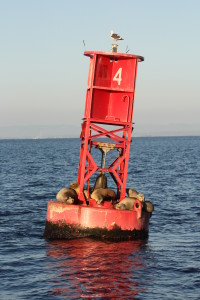
By Hoang-Nam Vu, Staff Writer for Save The Water™ | June 24, 2016
As the days get longer and the sun gets brighter, the word “summer” becomes more and more prevalent, and with the word “summer” comes to the word “beach.” The cool water, the soft sand, and the ocean air hold a certain allure that makes thousands of Americans flock to beaches each year. However, beach season comes with increased exposure to possible bacteria in the ocean water. This forces us to ask the question: what’s in the water?
Beach Buoy Ecological Development
Enter the beach buoy detection system. We know beach buoys as floating navigational markers, noting water areas for increased mindfulness and danger, but scientists are trying to give buoys a more ecological role. New technology has allowed scientists at Michigan State University to develop a “smart” buoy, one that is able to detect and evaluate the quality of the water around it. It functions through a combination of substance detection and statistical models to determine if the water holds a higher level of a substance than is safe. The sensors in the buoys gather the information from the water, such as temperature and clarity, and upload the data to a land-based server. Then, it sends the information to people who might need to make the decision to close the beach, as well as to web pages that allow the public to view the information.3
This method serves a major purpose. The initial model of the buoy detects levels of E. coli, a generic bacteria that often serves as an indicator for water contamination. While most strains of E. coli are harmless— the bacteria is often found in our intestinal tracts and is necessary for normal functioning—some are pathogenic. Shiga toxin-producing E. coli (STEC) is one of these pathogenic strains and is the one we often associate with food-borne outbreaks. These strains of pathogenic E. coli is known to cause diarrhea and related symptoms, and “can be transmitted through contaminated water or food, or through contact with animals or persons”.1 E. coli, an example of fecal coliform bacteria (a group of bacteria that passes through the fecal excrement of mammals), can transmit “ear infections, dysentery, typhoid fever, viral and bacterial gastroenteritis, and hepatitis A”.4
So does this mean that all water we encounter in our beach trips is contaminated with large amounts of pathogenic bacteria and that no one should go to the beach this summer in fear of contracting numerous diseases? While the latter may be a ridiculous statement, the former holds some truth to it. Of course, not all water contains a dangerously high level of pathogenic bacteria, and while the water may contain certain, healthy levels of bacteria, it should not deter us from taking a trip to the beach. However, it must be noted that in some situations, ocean water does contain dangerously high levels of bacteria, especially pathogenic strains, to the point where it is safer for the beach to be closed down at that time.
Beach Buoys Save The Day
Smart beach buoys work to alleviate this fear. Evaluating water quality and detecting abnormally high levels of bacteria in the water help provide information to beach officials for informed decisions. The Environmental Protection Agency has done much to protect the health of beach-goers—in 2014, they proposed guidance for state water quality testing grants under the Beaches Environmental Assessment and Coastal Health (BEACH) Act to use a new tool called the health-protective Beach Action Value (BAV) in order to make more protective swimming advisory decisions.2 However, the risk of pathogenic bacteria being present in water is still troubling. Smart beach buoys have been effective in determining the safety of the water we wade in: “In 2013 accuracy was 68–97%; specificity, 73–100%; and sensitivity, 0–36%”.5 Mantha Phanikumar, an MSU professor and member of the research team, said it best when describing the goal of the buoys: “Our ultimate goal is to protect the public from getting exposed to contaminated water… This problem can be particularly hard for children and seniors, who tend to be more susceptible to its dangers”. 3 After all, safety should always be on our minds. Hopefully, in the near future when we head down to the beach, we may not have to worry about the contents of the water due to the smart buoys.
References
- Centers for Disease Control and Prevention. November 6, 2015. “E.coli (Escherichia Coli) general information.” http://www.cdc.gov/ecoli/general/index.html
- J. Devine. June 30, 2014. “Testing the Waters 2014: A guide to water quality at vacation beaches.” https://www.nrdc.org/resources/testing-waters-2014-guide-water-quality-vacation-beaches
- Michigan State University. April 27, 2016. “Beach Buoys deployed to detect water contamination.” http://msutoday.msu.edu/news/2016/beach-buoys-deployed-to-detect-water-contamination/
- B. Oram. 2014. “Why is fecal coliform testing important – E. coli?” http://www.water-research.net/index.php/e-coli-in-water
- D.A., Shively, et al. January 15, 2016. “Prototypic automated continuous recreational water quality monitoring of nine Chicago beaches.” Journal of Environmental Management, 166, 285-93. doi:10.1016/j.jenvman.2015.10.011

